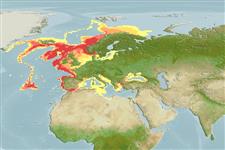Common names from other countries
Environment: milieu / climate zone / depth range / distribution range
Ecologia
; intervalo de profundidade 1 - 1829 m (Ref. 85345), usually 50 - 400 m (Ref. 125144). Subtropical; 72°N - 9°N, 19°W - 37°E
Northeast Atlantic, Eastern Central Atlantic and the Mediterranean.
Length at first maturity / Tamanho / Peso / Idade
Maturity: Lm ? range ? - ? cm
Depth based on occurrence (Ref. 2851, p. 719); to be replaced with better reference.
Life cycle and mating behavior
Maturidade | Reprodução | Desova | Ovos | Fecundidade | Larvas
Members of the class Asteroidea exhibit both asexual (regeneration and clonal) and sexual (gonochoric) means of reproduction. Life cycle: Embryos hatch into planktonic larvae and later metamorphose into pentamorous juveniles which develop into young sea stars with stubby arms.
Alves, F., L. Chicharo, A. Nogueira and J. Regala. 2003. (Ref. 2851)
Status na Lista Vermelha da IUCN (Ref. 130435: Version 2024-1)
Status no CITES (Ref. 108899)
Not Evaluated
Not Evaluated
Uso pelos humanos
| FishSource |
Ferramentas
Mais informação
Idade/TamanhoCrescimentoComprimento-pesoComprimento-comprimentoMorfologiaLarvasAbundância
Fontes da internet
Estimates based on models
Preferred temperature
(Ref.
115969): 1.7 - 10.5, mean 7.1 (based on 112 cells).
Categoria de preço
Unknown.
